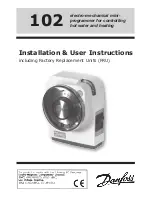
Solar Charge Controller 6830-122-C10/15/20
2013-06-25 9 Version 6
5 Protection, Troubleshooting and
Maintenance
5.1 Protection
·PV Array Short Circuit
If PV array short circuit occurs, clear it to resume normal operation.
·Load Overload
If the load current exceeds the maximum load current rating, the controller
will disconnect the load. Overloading must be cleared up through reapply
power or pressing the setting button.
·Load Short Circuit
Fully protected against load wiring short-circuit. After one automatic load
reconnect attempt, the fault must be cleared by reapply power or pressing the
setting button.
·PV Reverse Polarity
Fully protection against PV reverse polarity, no damage to the controller will
result. Correct the miswire to resume normal operation.
·Battery Reverse Polarity
Fully protection against battery reverse polarity, no damage to the controller
will result. Correct the miswire to resume normal operation.
·Damaged Local Temperature Sensor
If the temperature sensor short-circuited or damaged, the controller will be
charging or discharging at the default temperature 25
℃
to prevent the
battery damaged from overcharging or over discharged.
·Overheating Protection
If the temperature of the controller heat sink exceeds 85
°
C, the controller
will automatically start the overheating protection.
·High Voltage Transients
PV
is protected against high voltage transients. In lightning prone areas,
additional external suppression is recommended.
Solar Charge Controller 6830-122-C10/15/20
2013-06-25 10 Version 6
5.2 Troubleshooting
Trouble Shooting Table 5-1
Faults
Possible reasons
Troubleshooting
Charging LED
indicator off during
daytime when
sunshine falls on PV
modules properly.
PV
array
disconnection
Check that PV and battery
wire
connections
are
correct and tight.
Green charging LED
indicator
fast
flashing
Battery voltage
higher than over
voltage
disconnect
voltage(OVD)
Check if battery voltage
over high. Disconnect the
solar module
Battery
LED indicators are
orange
Battery
under
voltage
Load output is normal,,
charging LED indicator
will
return
to
green
automatically when fully
charged.
Battery
LED
indicators RED color
and
loads
not
working.
Battery
over discharged
The controller cut off the
output automatically, LED
indicator will return to
green automatically when
fully charged.
Solar Charge Controller 6830-122-C10/15/20
2013-06-25 11 Version 6
Digital tube displays
“L” with red slowly
flashing
Over load or short
circuit
Overload: Please reduce
the load and press the
button
once,
the
controller will resume to
work after 3s;
Short circuit: when the
first short-circuit occurs,
the controller will
automatically resume to
work after 10s; when a
second short-circuit
occurs, press the button,
the controller will
resume to work after 3s.
Digital tube displays
“H” with red slowly
flashing
Too high
temperature of
controller
When heat sink of the
controller exceeds 85
℃
, the controller will
automatically cut input
and output circuit. When
the temperature below
75
℃
, the controller will
resume to work
Notes: No LED indicator.
Measure battery voltage with multimeter.
Min.6V can start up the controller.
Notes: No charging status LED indicator with normal
connection. Measure the input voltage of solar module,
the input voltage must be higher than battery voltage!
Solar Charge Controller 6830-122-C10/15/20
2013-06-25 12 Version 6
5.3 Maintenance
The following inspections and maintenance tasks are recommended at least
two times per year for best controller performance.
•
Check that the controller is securely mounted in a clean and dry
environment.
•
Check that the air flow and ventilation around the controller is not blocked.
Clear all dirt or fragments on the heat sink.
•
Check all the naked wires to make sure insulation is not damaged for
serious solarization, frictional wear, dryness, insects or rats etc. Maintain or
replace the wires if necessary.
•
Tighten all the terminals. Inspect for loose, broken, or burnt wire
connections.
•
Check and confirm that LED digital tube is consistent with required. Pay
attention to any troubleshooting or error indication .Take necessary
corrective action.
•
Confirm that all the system components are ground connected tightly and
correctly.
•
Confirm that all the terminals have no corrosion, insulation damaged, high
temperature or burnt/discolored sign, tighten terminal screws to the
suggested torque.
•
Inspect for dirt, insects and corrosion, and clear up.
•
Check and confirm that lightning arrester is in good condition. Replace a
new one in time to avoid damaging of the controller and even other
equipments.
Notes: Dangerous with electric shock!
Make sure that all power source of controller is cut
off when operate above processes, and then make
inspection or other operations
!
!
!
!


























